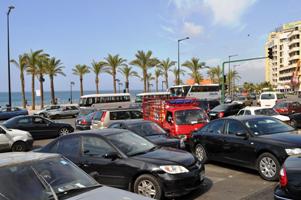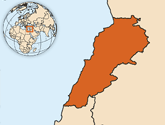 Traffic flows in Lebanon are chaotic with trucks, buses, pedestrians and motor vehicles all sharing the same space
Traffic flows in Lebanon are chaotic with trucks, buses, pedestrians and motor vehicles all sharing the same space
The number of registered vehicles in Lebanon has been growing exponentially in recent years reaching 1.4 million in 2007 compared to 783 000 in 1997. With a population that barely exceeds 4 million, Lebanon seems to be reaching its saturation point. Data on road safety are no less alarming.
According to Lebanese Internal Security Forces (ISF) data, the road safety predicament in Lebanon is greatly underestimated due to serious underreporting problems.
Road deaths in Lebanon have been steadily on the rise despite the lower crash rates at certain intervals, reaching a peak in 2007. Injury rates, on the other hand, followed a trend that paralleled crash rates.
Lebanese legislations set speed limits on urban roads nationally at 100 km/h and allowed local authorities to set lower limits. However enforcement of speed limits is only effective at a rate of 4 to 10 which is low but is much more effective than the enforcement of the drink-driving law. The legal limit in the latter is set at 0.05g/dl but barely has any efficacy when it comes to enforcement. Random breath testing and/or police checkpoints are occasionally set but there is no tracking of data related to road deaths caused by alcohol consumption. The seat-belt wearing rate remains low; the Lebanese Internal Security Forces reported that only 15% of the population buckled up in 2007. Enforcement effectiveness scores low too. On the other hand, Lebanon has not yet introduced a child restraints law. As for helmet wearing rates, no data are available. Despite a motorcycle helmet law, helmet standards are not mandated and weakly enforced.
The overall goal of the traffic safety programme is to support the Lebanese government in implementing good practices to reduce deaths and injuries due to road traffic collisions. The focus of the programme is on speeding and on seat-belt wearing. In addition to the road safety prevention work, national and international partners will focus on data system development.
WHO launched the initiative of elaborating the third Global status report on road safety. This report is expected to be launched before the mid-term ministerial review meeting for the Decade of Action for Road Safety 2011–2020 (tentatively scheduled for late 2015). This third report will assess how far countries around the world have come in implementing the specific actions outlined in the Global Plan for the Decade of Action. While a similar methodology to that used for the first two reports will be applied, in order to allow comparisons with the previously published data, refinements will be made to improve the quality and depth of information in some areas.
WHO Lebanon, with the help of the national data coordinators, conducted the consensus meeting for the report on 19 March 2014 gathering all focal points that filled the respective part of the questionnaire related to the scope of work of their institutions (ministries, administrations). The meeting succeeded in obtaining a concurrence to the filled questionnaire as representing the national data on road safety in Lebanon.





